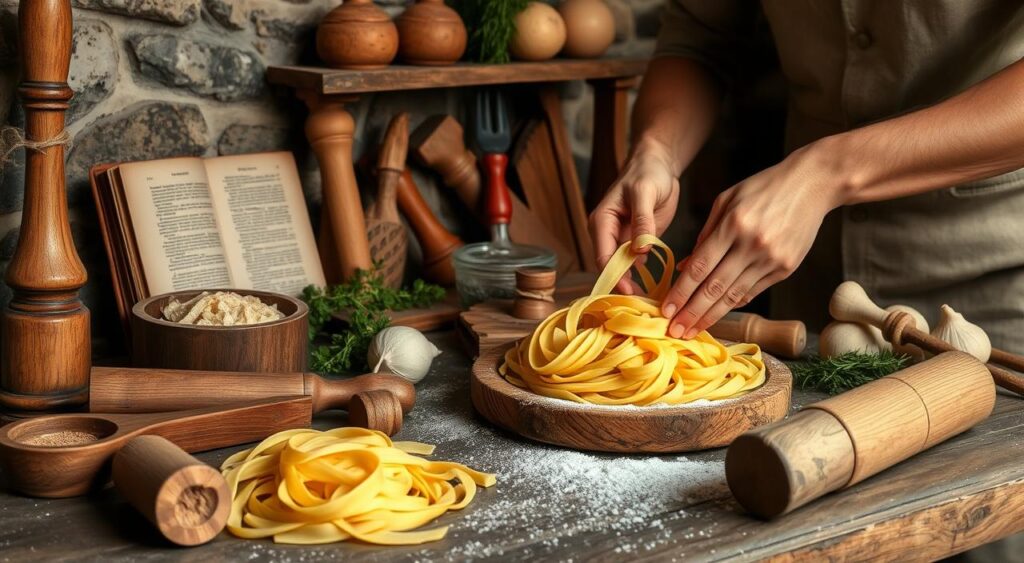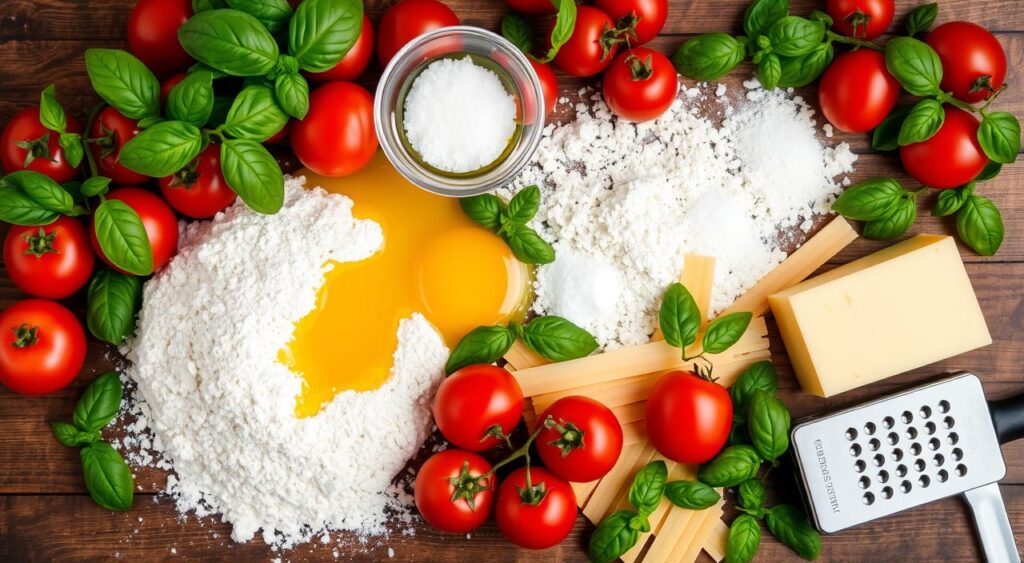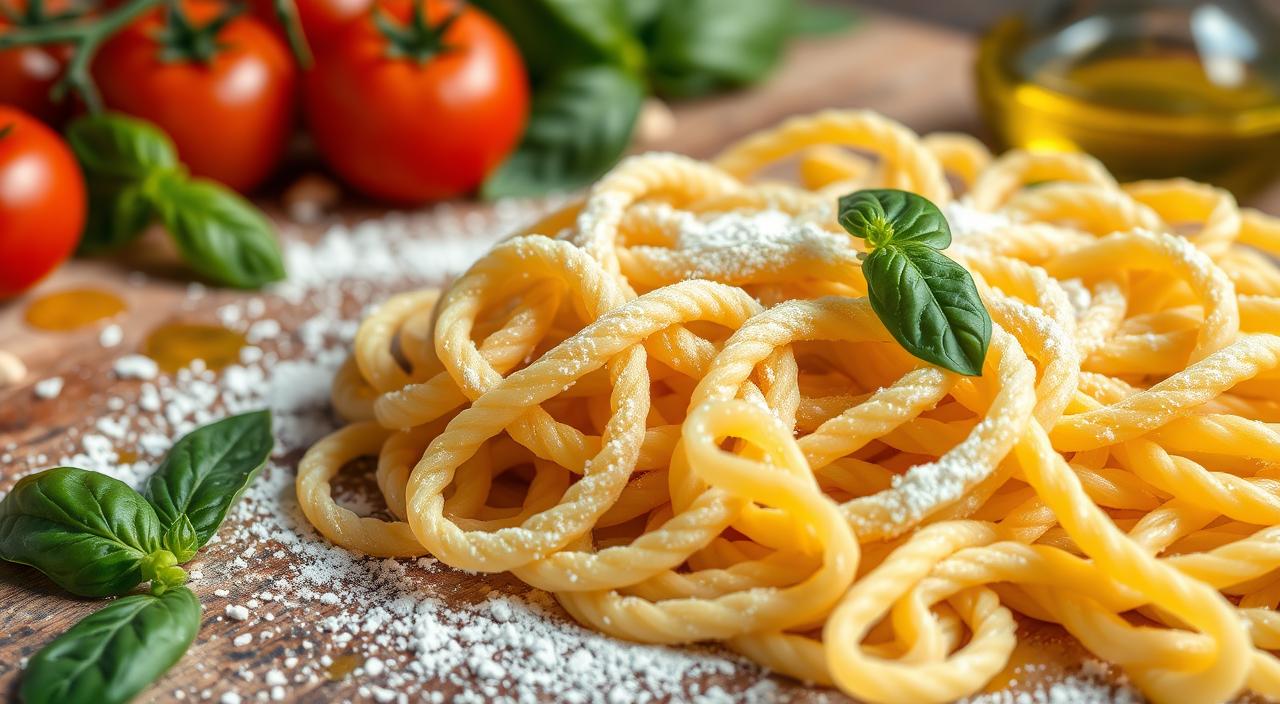I’ve always been drawn to Italian cuisine, and strozzapreti caught my eye. The name, “priest strangler,” made me curious. I wanted to learn more about this unique pasta.
Let’s explore how to make authentic Italian strozzapreti pasta. It’s a true delight for the senses.
Strozzapreti is a handmade pasta from Italy and San Marino. It looks like twisted ropes. This shape helps it hold onto bold flavors well.
Unlike many pastas, strozzapreti uses all-purpose flour and semolina. It’s moistened with warm water, without eggs. This gives it a rustic, authentic texture.
Understanding Strozzapreti: Origins and History

Strozzapreti, a traditional Italian pasta, has a rich history. The name “strozzapreti” means “priest strangler” or “priest choker.” There are many legends about how it got its name.
One story says greedy priests ate it so fast they choked. Another tale tells of housewives cursing the pasta. They hoped to punish priests for their gluttony.
The Story Behind the Name “Priest Strangler”
The strozzapreti pasta started in the 17th century. The Papal State was in power then. The name shows the dislike for the clergy in the area.
Despite the fun stories, the name’s true origin is still debated. Historians and food lovers can’t agree.
Regional Variations in Italy
While strozzapreti is linked to places like Emilia-Romagna and Tuscany, it has changed over time. In some places, it’s a dumpling made with ricotta and spinach, not the traditional pasta.
Traditional Cultural Significance
Strozzapreti is more than just pasta. It’s a symbol of Italian culture. Its unique shape shows the skill and tradition of Central Italy.
Even though you can buy dried strozzapreti, making it at home is special. It’s a part of family traditions and regional cuisine.
Essential Ingredients for Perfect Strozzapreti

Making authentic strozzapreti, the classic Italian pasta, needs careful ingredient selection. At its core are two flours: all-purpose flour and semolina flour. These flours create the perfect texture and consistency for the pasta.
For seasoning, you’ll need salt. And to mix the ingredients, use warm water. Some recipes might include eggs or egg yolks. But traditional strozzapreti often skips them for a more authentic taste.
“The key to perfect strozzapreti lies in the balance of flours and the right amount of warm water to create a pliable, yet firm dough.”
With these key strozzapreti ingredients, you’re ready to make a truly Italian pasta recipe. It will capture the rustic essence of this beloved dish.
Tools and Equipment Needed
Making authentic Italian strozzapreti pasta at home is simple with the right pasta-making tools and basic kitchen gear. You don’t need a pasta machine to make delicious homemade pasta. What’s important is having the right Italian cooking equipment and knowing the handmade pasta techniques.
Traditional vs. Modern Tools
Traditionally, people used a wooden board or clean marble, a rolling pin, and a knife or pastry cutter to make strozzapreti. These tools help you knead, roll, and shape the pasta by hand. For a modern twist, a stand mixer with a dough hook can knead the dough quickly.
Workspace Setup Requirements
It’s crucial to have a clean, spacious, and lightly floured workspace for making strozzapreti pasta. A large wooden or marble surface, like a sturdy kitchen table or countertop, is ideal. Keep the area organized and clutter-free for a smooth pasta-making experience.
Optional Equipment for Efficiency
While not essential, some pasta-making tools can make the process easier and ensure better results. A pasta machine can help roll the dough to the right thickness. A pasta drying rack is also helpful for drying your handmade strozzapreti before cooking.
Preparing the Perfect Pasta Dough
Making the perfect pasta dough is key to authentic Italian Strozzapreti pasta. Start by mixing 200g of pasta flour and a pinch of salt in a big bowl. Add 120g of warm water slowly, stirring with a fork until it forms a ball.
Once it’s a ball, put it on a floured surface. Knead it for 4-5 minutes until it’s smooth and elastic.
After kneading, wrap the dough in plastic wrap. Let it rest for at least 30 minutes. This helps the dough relax, making it easier to roll and shape. Use this time to prepare your tools for the Italian dough techniques needed for homemade pasta.
When the dough is ready, divide it into parts. Start shaping it. Follow these steps to make the classic pasta dough recipe for the tasty Strozzapreti pasta dish.
Step-by-Step Strozzapreti Rolling Technique
Learning to make strozzapreti is crucial for authentic Italian pasta. This method, passed down for generations, gives strozzapreti its unique twisted shape. It makes them stand out from other pasta types.
Basic Shaping Method
Start by rolling the pasta dough to 1/8 inch thickness. Cut it into strips, 1 to 1.5 inches wide. Stretch each strip and twist it between your palms, making a tube shape. Tear off pieces about 4 inches long as you twist.
Troubleshooting Common Shaping Issues
If your strozzapreti break or lose shape, the dough might be too dry. Make sure it’s moist enough to hold its shape. Also, practice and patience are essential for even strozzapreti.
Tips for Achieving Uniform Size
To get even strozzapreti, use your fingers as a guide when tearing. Or, wrap the dough around a thin rod for the right shape and length. With practice, you’ll get the hang of making perfect Italian pasta.
Drying and Storing Your Handmade Pasta
Keeping your homemade strozzapreti pasta fresh and tasty is key for a true Italian meal. After shaping, drying and storing it right is important. This helps keep its perfect al dente texture.
First, lay the shaped pasta on a floured baking sheet. For quick storage, dust it with flour and chill it for up to 3 days. This keeps the pasta from sticking.
For longer storage, freeze the pasta. Lay it out on a baking sheet lined with waxed paper and freeze until solid. Then, put it in an airtight bag or container. Frozen pasta cooks well straight from the freezer, just add 1-2 minutes to cooking time.
“Properly dried pasta should be completely dry, brittle, and snap easily before storage to prevent mold growth and spoilage.”
Proper pasta preservation and homemade pasta storage are essential for enjoying Italian food at home. By using these drying and freezing tips, you can enjoy your handmade strozzapreti whenever you want.
Fresh pasta lasts only a short time because it’s very moist. It should be cooked right away. Dried pasta, however, can last months in a cool, dark place in an airtight container.
Cooking Techniques for Perfect Al Dente Strozzapreti
Getting the perfect al dente texture for your homemade strozzapreti pasta is key. It’s all about mastering the right cooking techniques. These techniques will make your hand-rolled pasta truly special.
Water Temperature and Salt Ratios
First, boil a large pot of water. Don’t forget to add plenty of salt. Use about 1 tablespoon of salt for every 4 cups of water. The salt not only adds flavor but also helps the pasta cook just right.
Timing and Testing for Doneness
Fresh strozzapreti pasta cooks in 3-4 minutes. Dried pasta might take 4-5 minutes. The best way to check if it’s done is to taste it. It should be tender but still have a bit of chew.
By using these cooking tips, you’ll enjoy your homemade strozzapreti pasta just like it’s made in Italy. Serve it with your favorite sauces for a truly memorable meal.
Best Sauce Pairings and Serving Suggestions
Traditional Italian pasta sauces pair well with strozzapreti pasta. Its twisted shape holds onto chunky sauces perfectly. Try it with ragù alla bolognese, creamy sausage sauces, or vegetable-based sauces.
For a lighter option, strozzapreti works great with vegan pesto. Always top your dish with Parmigiano Reggiano or Pecorino Romano cheese. It adds a rich flavor.
The shape of strozzapreti pasta makes it perfect for sauces. It ensures every bite is full of flavor. Whether you choose a hearty or light sauce, strozzapreti brings a true taste of Italy to your plate.
Conclusion
Making homemade Italian pasta, like strozzapreti, is a fun journey. It connects you to old cooking traditions. You can make tasty dishes at home, just like in restaurants. Try different sauces to find your favorite way to enjoy this pasta.
Whether you’re a pro in the kitchen or new to making pasta, strozzapreti is a great start. It lets you see Italy’s rich culture. You’ll learn about its history and how to shape the pasta perfectly.
Keep exploring homemade Italian pasta and enjoy strozzapreti’s versatility. It’s a standout pasta shape that goes well with many sauces. Whether you choose a classic tomato sauce or something new, strozzapreti will delight your taste buds and impress your friends.
FAQ
What is strozzapreti pasta?
Strozzapreti is a handmade pasta from Italy. It’s loved in places like Emilia-Romagna and Tuscany. This pasta looks like twisted ropes and goes great with thick sauces.
What is the origin of the name “strozzapreti”?
The name “strozzapreti” means “priest strangler.” There are two stories about it. One says priests ate too fast and choked. The other claims housewives cursed the pasta to punish priests for eating too much.
What are the key ingredients for authentic strozzapreti?
To make real strozzapreti, you need flour, semolina flour, salt, and warm water. These ingredients give the pasta its perfect texture.
What tools are needed to make strozzapreti?
You’ll need a bowl, fork, board, rolling pin, and knife. A pasta machine is good for making the pasta even.
How do you shape strozzapreti?
First, roll the dough to 1/8 inch. Cut it into strips and stretch them. Then, twist each strip between your palms to shape it.
How do you cook and serve strozzapreti?
Boil strozzapreti in salted water for 3-4 minutes if it’s fresh. For dried pasta, boil for 4-5 minutes. It’s best with thick sauces like ragù alla bolognese or creamy sausage sauces.
